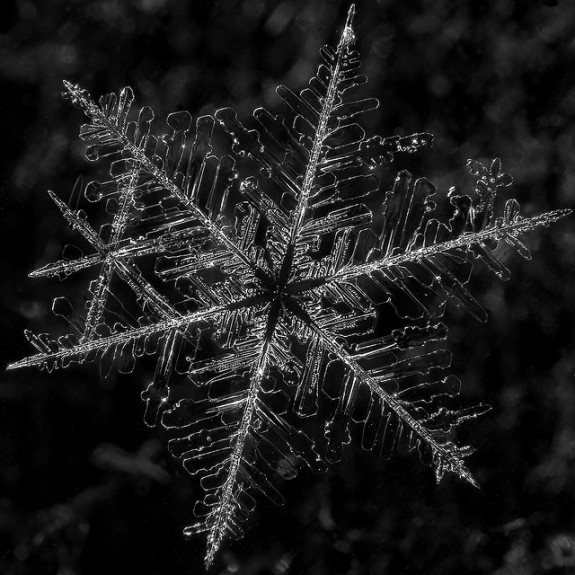Snowflakes May Have Different Designs, But They Always Have Six Sides
The chemistry of water gives rise to the intricate beauty of snowflakes

Photo: Margus Kulden
In the skies high above, a solitary snowflake is forming. Seeded by a speck of debris—dust, salt, a bacterium carried aloft—the tiny, delicate crystal grows and grows, with ever-more water depositing on to its surface as the flake is buffeted about within the cloud. When the snowflake gets big and heavy enough it falls, changing its form as it encounters the steadily-warming temperatures near the surface.
According to the Bytesize Science podcast of the American Chemical Society, these temperature shifts lend the snowflakes their intricate patterns:
Though snowflakes are beautifully varied, there is one underlying pattern that is seldom broken: snowflakes’ intricate patterns (almost) always have six sides. The reason why, says science blogger Megan Nantel, is because snowflakes are made of water, and water molecules bonded together take on particular shapes.
Linda Gaines for Double X Science:
In the case of water molecules bonding to other water molecules, the two slightly negative areas of the oxygen can each bond with a slightly positive hydrogen from another water molecule. When all four slightly charged areas have each bonded with another water molecule via hydrogen bonding, the result is a tetrahedral (four-sided pyramid) shape. …As the water freezes, these tetrahedrons come closer together and crystallize into a six-ring or hexagonal structure.
The hexagonal shape of water molecules bonded together persists as the snowflake grows and grows, meaning that the tiny form of a beautiful snowflake is also a window into the even tinier, but no less beautiful realm of the individual chemical bonds at its core.
More from Smithsonian.com:
Freeze Frame
/https://tf-cmsv2-smithsonianmag-media.s3.amazonaws.com/accounts/headshot/smartnews-colin-schultz-240.jpg)
/https://tf-cmsv2-smithsonianmag-media.s3.amazonaws.com/accounts/headshot/smartnews-colin-schultz-240.jpg)